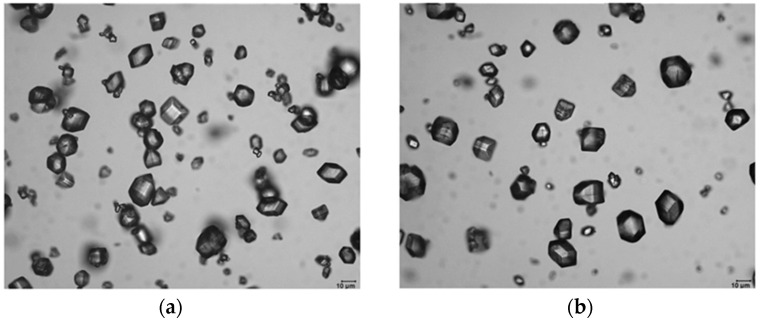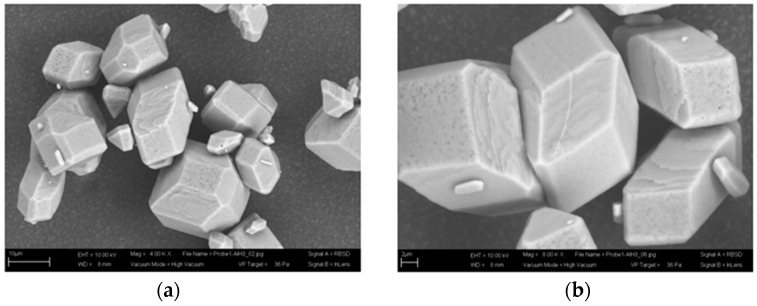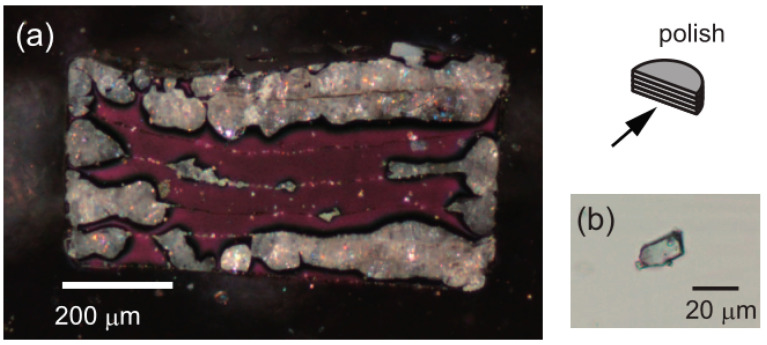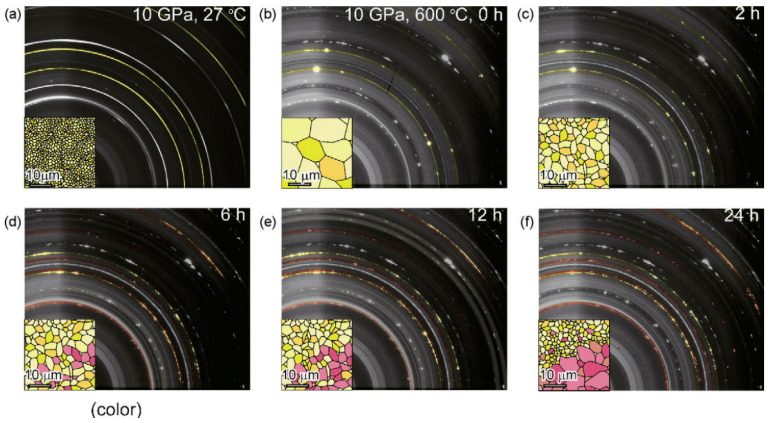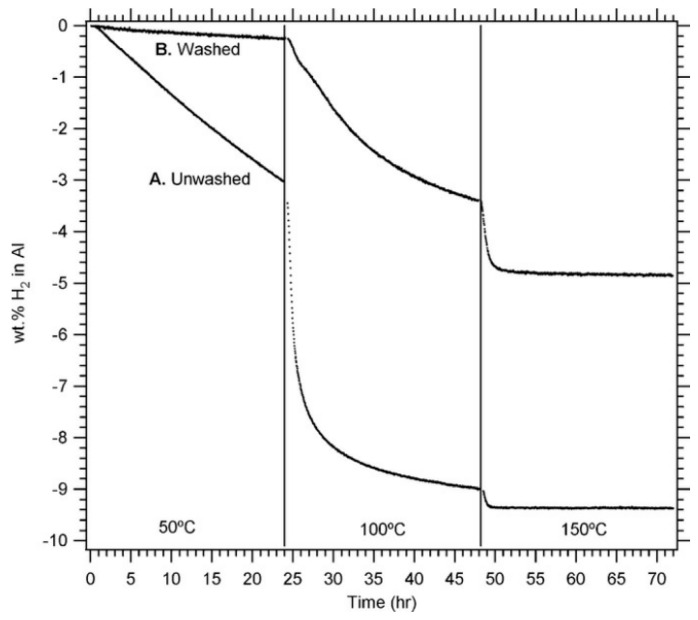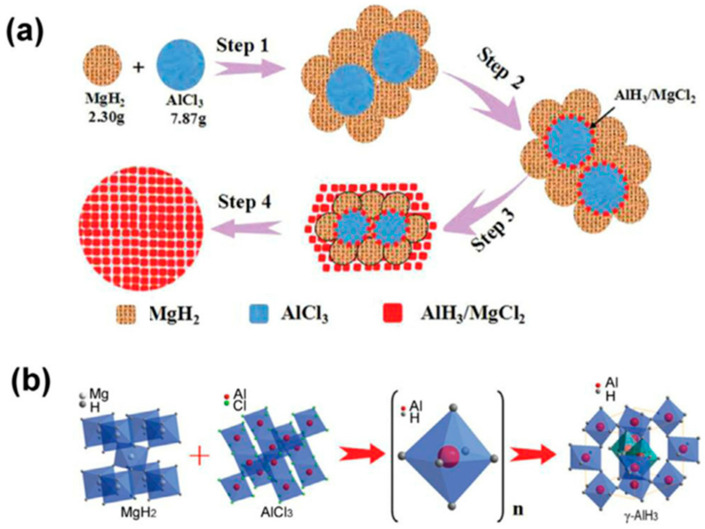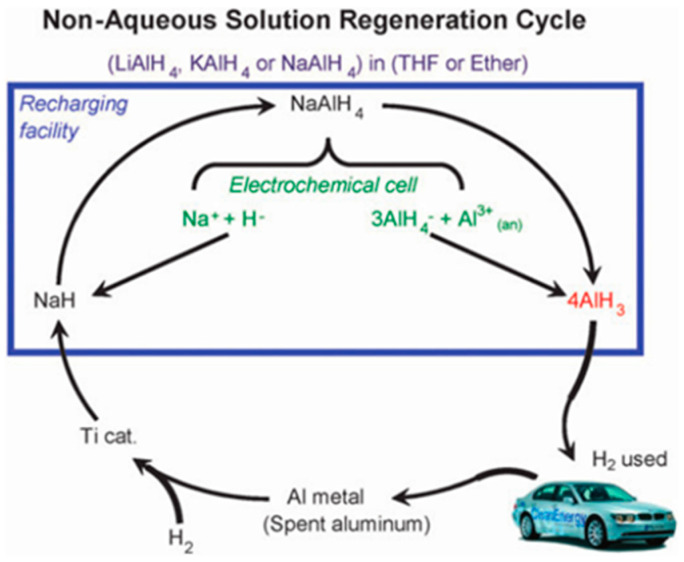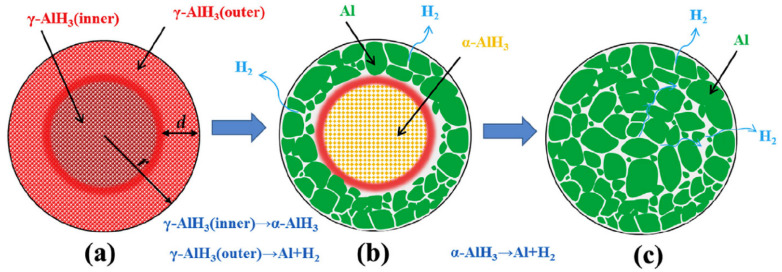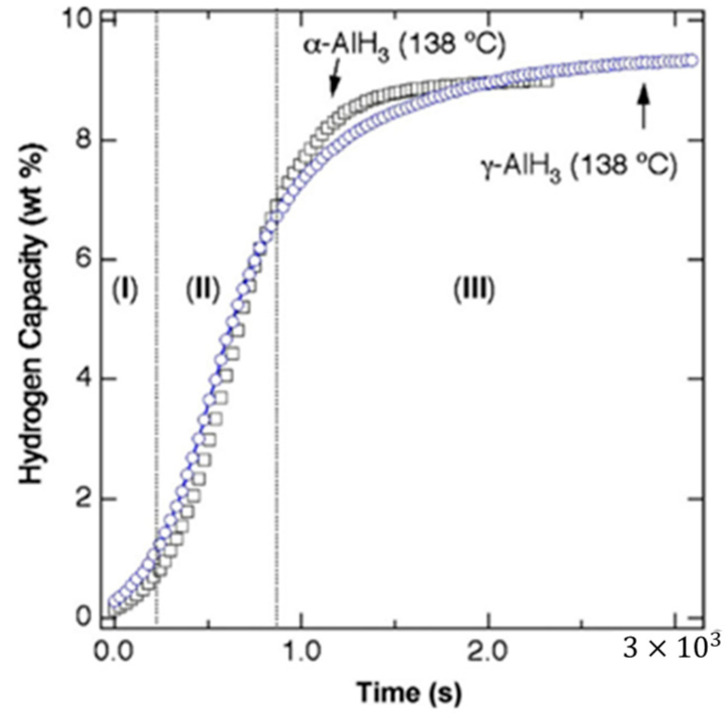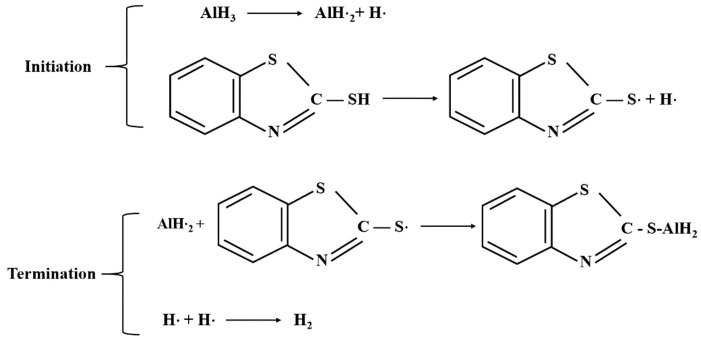Abstract
Aluminum hydride (AlH3) is a binary metal hydride with a mass hydrogen density of more than 10% and bulk hydrogen density of 148 . Pure aluminum hydride can easily release hydrogen when heated. Due to the high hydrogen density and low decomposition temperature, aluminum hydride has become one of the most promising hydrogen storage media for wide applications, including fuel cell, reducing agents, and rocket fuel additive. Compared with aluminum powder, AlH3 has a higher energy density, which can significantly reduce the ignition temperature and produce H2 fuel in the combustion process, thus reducing the relative mass of combustion products. In this paper, the research progress about the structure, synthesis, and stability of aluminum hydride in recent decades is reviewed. We also put forward the challenges for application of AlH3 and outlook the possible opportunity for AlH3 in the future.
Keywords: AlH3, hydrogen storage, high energy material, stability
1. Introduction
Aluminum hydride (AlH3) has great potential applications in rocket fuel and fuel cell due to its high combustion heat and high hydrogen content [1,2,3]. The bulk hydrogen density of AlH3 is 148 (more than twice of liquid hydrogen), and the weight hydrogen density is more than 10%, which meets the requirements of the U.S. Department of Energy (DOE) for hydrogen and energy storage materials [4,5,6,7,8,9]. AlH3 also has the advantages of low reaction heat and rapid hydrogen release rate. However, AlH3 is unstable and easy decomposition occurs at room temperature, and it can react with water vapor and oxygen in the environment, resulting in the release of hydrogen. Therefore, how to improve the stability of AlH3 has become the key problem to be solved in the practical application of AlH3 [10].
In recent years, researchers are committed to breaking through the bottleneck problems in the practical application of AlH3, including improving the synthesis method [11,12,13,14], coating or doping of AlH3 [15,16,17], and providing a deep understanding of the thermodynamics and kinetics of AlH3 [18,19,20]. This review focuses on the recent studies on AlH3. In this review, we first introduce the physical and chemical properties of aluminum hydride, including crystal structure and thermal decomposition reaction kinetics. Next, the common synthesis methods of aluminum hydride are described. Last, we put forward the methods to improve the stability of aluminum hydride and outlook the possible opportunities for application of AlH3 in the future.
2. Physical and Chemical Properties
There are at least seven different crystal structures of AlH3 due to the different synthesis routes and reaction conditions (mainly referring to the reaction time and temperature) [21,22]. Brower et al. [23] first synthesized phase of non-solvated aluminum hydride, and then successfully synthesized six other AlH3 polymorphs: . It has been proved by experiment and theory that the crystal phase is the most stable one, followed by the and crystal phase [24]. Figure 1 shows several common structures of AlH3 polymorphs [10]. The α phase belongs to the trigonal space group (), with the lattice parameters of a = 4.449 Å and c = 11.804 Å [25]. The structure is composed of alternating planes of H and Al atoms, which are stacked perpendicularly to the C-axis. There are six H atoms around each Al atom to form regular octahedral coordination. Because the Al atom has only three bonding electrons, two Al atoms form the Al-H-Al electron deficient bridge bond by sharing one electron of H atom. The structure is composed of an Al-H-Al bridge bond, which connects the atoms in the whole unit cell into a relatively stable whole. Therefore, the α phase has good chemical stability in macroscopic view. The crystal parameters of the phase are listed in Table 1. The phase belongs to the cubic space group (Fdm), with the lattice parameters of a = 9.004 Å [26]. The phase belongs to the orthorhombic space group (Fdm), with the lattice parameters of a = 5.3806(1) Å, b = 7.3555(2) Å, c = 5.77509(5) Å [21]. and will spontaneously convert to at around 100 °C [27], and the reaction heats of polymorph transformations are: 1.5 for the → transition and 2.8 for the → transition [24]. According to the reaction heat of the polymorph transformation, is proved to be the most stable phase. Therefore, only the phase has a practical application value. In this review, all aluminum hydride involved is phase except for special indication.
Figure 1.
Structures of AlH3 polymorphs of , , , . Reprinted with permission from Ref. [10]. Copyright 2009 Elsevier.
Table 1.
| Crystal System | Trigonal |
|---|---|
| Space group | hexagonal axes |
| (167) | |
| Formula per unit cell, [Z] | 6 |
| Lattice parameters | A = b = 4.449 Å |
| c = 11.804 Å | |
| = = 90°, = 120° | |
| Density | 1.477 g/cm3 |
| Molecular weight | 30.01 g/mol |
is a white nonvolatile hexagonal crystal with a density of 1.477 , the theoretical hydrogen content of 10.08%, insoluble or slightly soluble in ether, soluble in tetrahydrofuran, and inert to hydrazine [29,30]. When exposed to water, the pure hydrolyzes slowly, and takes several hours for complete hydrolyses [31,32]. can be stored for several months at room temperature, and it begins to decompose at 100 °C, releasing hydrogen and forming aluminum [33]. The optical and scanning electron microscopy pictures of are reported (as shown in Figure 2 and Figure 3). It can be seen that is a dense and transparent crystal with a good crystal plane and crystal edge configuration [28].
Figure 2.
Optical microscopy pictures of . (a,b) are optical microscope pictures of at different magnification. Reprinted with permission from Ref. [28]. Copyright 2009 WILEY-VCH Verlag GmbH & Co. KGaA, Weinheim.
Figure 3.
SEM pictures of . (a,b) are SEM pictures pictures of at different magnification. Reprinted with permission from Ref. [28]. Copyright 2009 WILEY-VCH Verlag GmbH & Co. KGaA, Weinheim.
3. Synthesis Methods
3.1. Liquid Phase Synthesis Methods
In 1942, Stecher and Wiberg [34] first prepared with low yield and purity by liquid phase synthesis. A few years later, Finholt et al. [35] prepared a solution of AlH3 in ether by the reaction of LiAlH4 and AlCl3. The chemical equation of the reaction is:
| (1) |
Finholt et al. [35] also proposed another reaction route for the preparation of AlH3: the reaction of LiH and AlCl3 in ether solution. The chemical equation of the reaction is as follows:
| (2) |
For these two different reaction pathways, Finholt et al. [35] found that although Reaction (2) was simpler, Reaction (1) was more stable and rapid. At the same time, the target product of Reaction (2) can easily continue to react to form LiAlH4, so Reaction (1) was considered to be a better choice. The final product prepared by Finholt et al. was with a yield of 85%. However, due to the presence of a certain amount of ether in the final product, how to remove the ether without loss of hydrogen becomes the focus of the next step.
In 1955, Chizinsky [36] prepared AlH3 without ether solvent for the first time. The AlH3 ether solution prepared by the usual method was filtered into inert liquid (pentane and ligroin), and then dried under a high vacuum for 12 h. However, Chizinsky’s experimental results have not been effectively repeated. In 1975, Brower et al. [23] published a summary on the preparation of AlH3. They synthesized seven different polymorphs of AlH3. The synthesis method is similar to that of Stecherand Wiberg [34] and Finholt et al. [35], namely the metathesis reaction between LiAlH4 and AlCl3 (Reaction (3)), and then the ether is removed by heating the mixed solution of ether and toluene with the good solubility of ether in toluene (Reaction (4)).
| (3) |
| (4) |
Brower et al. [23] found that the pure AlH3 etherate would decompose and result in loss of hydrogen when heated in vacuum, but if there was excessive LiAlH4, the ether in AlH3 etherate could be removed. They also found that excess LiAlH4 can decrease the time and temperature of desolvation. The mixed use of LiAlH4 and LiBH4 can further reduce the temperature and time of desolvation reaction. However, when only LiBH4 exists and LiAlH4 is absent, desolvation cannot be achieved [23]. When the molar ratio of LiAlH4: AlH3: LiBH4 is 1:4:1, is prepared [23]. Brower et al. [23] carried out X-ray analysis of the prepared γ—AlH3 and found that it has the same X-ray powder pattern as the sample reported by Chizinsky. Therefore, Chizinsky’s experimental results are considered to be caused by accidental use of excessive LiAlH4.
Different polymorphs of AlH3 can be prepared by slightly adjusting Reactions (3) and (4). was prepared by reducing the molar ratio of LiBH4 and reacting at low temperature, while and were prepared in the presence of a small amount of water. These nonsolvated phases are not considered to be converted into , and their thermal stability is much worse than that of [23].
Brower et al. [23] also designed a process to prepare a large number of microcrystalline : ether solution was prepared according to Reaction (3), and then desolvent in toluene (or benzene) using a crystallization flask with a fractionator. After that, the researchers proposed a variety of liquid-phase synthesis methods of AlH3. The researchers found that etherated or pure AlH3 could be prepared by the reaction of binary hydrides or tetrahydroaluminates (aluminates) of the first and second groups with Bronsted-Lewis acids such as AlCl3 [37].
In recent years, researchers have improved the wet synthesis process. Bulychev et al. [38] synthesized unsolvated AlH3 by the reaction of AlBr3 or sulfuric acid with LiAlH4 in pure toluene or in toluene containing 5–10 wt% diethyl ether. However, the unsolvated AlH3 is not a high-purity crystal, and the concentrated sulfuric acid used in the reaction process is comparatively dangerous.
Lacina et al. [39] carried out vacuum distillation for the mixed solution of ether compounds, and successfully obtained micrometer grade α—AlH3 by using a variable temperature solvent crystallization method. Graetz et al. [40] reported a low-temperature, low-pressure, reversible reaction using titanium-doped aluminum powder and triethylenediamine (TEDA) to regenerate AlH3. They first prepared AlH3 by a traditional method, then doped it with β-TiCl3. After that, the samples were dried and decomposed in vacuum to produce active aluminum powder containing titanium. AlH3-TEDA can be regenerated by the reaction of the active aluminum powder with hydrogen and TEDA in THF solution at a lower temperature and pressure.
Although the liquid-phase synthesis method of AlH3 has been mature and perfect, the liquid-phase synthesis method itself has some disadvantages, such as being unsafe, consuming a lot of solvents, involving a complex follow-up processing, and so on. Therefore, the new synthesis method without solvent has attracted the attention of researchers.
3.2. Dry Synthesis
As mentioned above, the synthesis of AlH3 in solvents requires a lot of solvents, and most of these solvents are expensive and toxic, so the method of synthesizing AlH3 without liquid phase solvents has been developed. One way of dry synthesis is to make aluminum react with hydrogen directly under high pressure to produce AlH3. Baranowaski and Tkacz [41] have systematically measured the equilibrium between gaseous hydrogen and solid aluminum hydride in the temperature range of 100–150 °C and pressure range of 0–12 kPa. The results show that AlH3 can be synthesized only when the temperature exceeds 140 °C [41]. Appel and Frankel [42] bombarded pure aluminum target samples with deuterons. The X-ray diffraction patterns of the samples showed that a new phase was formed. By comparison, it was confirmed that AlH3 was obtained on the surface of the aluminum target [42].
Saitoh et al. [43] prepared AlH3 via reacting aluminum with hydrogen at 650 °C and 10.0 GPa for 24 h. They measured the morphology change of aluminum, as shown in Figure 4, and found that the surface of aluminum is covered with a layer of white particles, which are colorless and transparent crystals under the transmission light microscope. The white particles were confirmed to be AlH3 by powder X-ray diffraction.
Figure 4.
(a) Polarized micrograph of a longitudinal section of a recovered disk sample hydrogenated at 650 °C and 10.0 GPa for 24 h. (b) Transmitted light micrograph of the obtained AlH3 single crystal. Reprinted with permission from Ref. [43]. Copyright 2008 AIP Publishing.
Saitoh et al. [44] studied the reaction process of aluminum and hydrogen at 10 GPa and 600 °C by in situ X-ray diffraction. As shown in Figure 5, the X-ray diffraction images of the samples are collected every 10 min during the hydrogenation process [44]. The yellow and red particles represent Al and AlH3 particles, respectively. Saitoh et al. found that the growth process of AlH3 single crystal will go through three stages: self-pulverization of aluminum (with the increase of reaction time, it is found that the size of aluminum Bragg lattice decreases), hydrogenation of pulverized aluminum (X-ray diffraction image shows a new Bragg lattice), and solid-state grain growth of AlH3 [44].
Figure 5.
X-ray diffraction images of the sample during the hydrogenation. (a) Complete Debye rings from aluminum at 10 GPa, 27 °C. (b) Bragg spots from aggregated aluminum (colored in yellow). This image was taken immediately after the sample was heated to 600 °C at 10 GPa. (c–f) Diffraction images taken after 2 h, 6 h, 12 h, and 24 h heat treatment at 10 GPa, 600 °C. Reprinted with permission from Ref. [44]. Copyright 2010 Elsevier.
The direct reaction of aluminum and hydrogen under high pressure to produce AlH3 often requires strict reaction conditions and low yield, so this kind of method is not considered as a good choice [45]. It is considered that mechanical ball milling is a simple and feasible method for the synthesis of metal compound hydrides. Mechanical ball milling has been used to synthesize Mg(AlH4)2 [46,47], Ca(AlH4)2 [48,49], LiMg(AlH4)2 [50], and so on. Brinks et al. [22] first proposed the mechanical ball milling method to prepare AlD3. They prepared AlD3 by using the mixed ball milling of 3LiAlD4 and AlCl3. Brinks et al. [22] found that in addition to AlD3 ( and ), the mixture of LiCl and Al was also produced in planetary milling at room temperature, while only AlD3 and LiCl were produced in freezing ball milling at 77 K. Sartori et al. [51] found that AlH3 can be prepared by cryomilling aluminium halides and alanate. They also found that the yield of AlH3 can be increased by using 3LiAlD4 + AlBr3 and 3NaLiAlD4 + AlCl3 compared with using 3LiAlD4 + AlCl3.
Paskevicius et al. [52] studied the structure of AlH3 prepared by mechanical grinding, and found that some and were formed in the product. After ball milling, LiCl in the product was removed via washing with nitromethane/AlCl3 solution, and AlH3 separated from the by-product was obtained. However, the AlH3 nanoparticles adversely reacted with the nitromethane/AlCl3 solution. The hydrogen desolvation kinetics of the washed samples were significantly hindered compared to the unwashed samples [52]. The hydrogen desorption ability of the washed sample is only half of that unwashed sample, as shown in Figure 6.
Figure 6.
Hydrogen desorption data from (A) unwashed and (B) washed samples cryogenically milled for 1 h with a 2:1 LiCl:AlH3 volume ratio. Reprinted with permission from Ref. [52]. Copyright 2009 Elsevier.
Duan et al. [53] proposed a cost-effective solid-state reaction grinding method with cheap metal hydride and aluminum chloride as the starting reagents to synthesize AlH3. They found that nano-sized can be synthesized by reactive milling the AlCl3 and MgH2 nanocrystalline. According to XRD, NMR, and TEM analysis, the average size of the as-synthesized phase was estimated to be around 8.5 nm [53]. Duan et al. [54] also found that MgH2 can be stably converted to in the process of grinding the MgH2/AlCl3 mixture. Further studies by TEM, SEM, and NMR showed that the amorphous intermediate (AlH6)n was synthesized preferentially and recrystallized to at the end of the reaction [54]. Surface nanocrystallization is considered to be a key step in mechanochemical synthesis of AlH3, and the synthesis process can be shown in Figure 7 [55].
Figure 7.
(a) The pathway of the mechanically activated reaction between MgH2 and AlCl3. (b) Mechanism of the solid state synthesis of nano-sized . Reprinted with permission from Ref. [56]. Copyright 2021 Elsevier.
Hlova et al. [57] studied the mechanical grinding process for the synthesis of AlH3 from LiH and AlCl3 at room temperature. The intermediates and final products were characterized by powder X-ray diffraction and solid-state 27Al NMR spectroscopy. The experimental results show that adding AlCl3 slowly during ball milling can prevent the formation of unnecessary intermediate products. At the same time, if the reaction is carried out at 3 MPa hydrogen pressure, the final products are not easy to decompose.
Although the mechanical ball milling method has its unique advantages to synthesize AlH3, it is difficult to be used in large-scale production due to its complex preparation process, high reaction conditions (usually at a low temperature or liquid nitrogen), mixed crystal phase of reaction products, and difficult purification.
3.3. Other Synthetic Methods
In the process of synthesizing AlH3 by mechanical ball milling, the reactants are heated unevenly, and other complex crystal phases are often produced. Therefore, other synthetic methods of AlH3 have been proposed in recent years. Supercritical technology is a new experimental method and plays an increasingly important role in chemical separation and synthesis. McGrady [58] prepared AlH3 by supercritical technology. In a pressure vessel without water and oxygen, aluminum powder and 2% catalyst (TiCl3) were mixed evenly, and liquid carbon dioxide (89 MPa) and hydrogen (50 MPa) were introduced, heated to 60 °C to reach supercritical state, stirred at a rate of 150 r/min for 1 h, and then cooled to room temperature to obtain gray powder AlH3. However, due to the limitation of experimental conditions, supercritical technology cannot be applied to the actual production of AlH3.
Zidanet al. [59] synthesized by an electrochemical method for the first time: AlH3·nTHF adduct was obtained by electrolysis with THF as solvent, NaAlH4 as electrolyte, aluminum as anode, and platinum as cathode. Due to the strong binding force of AlH3·nTHF, AlH3·TEA was synthesized by introducing triethylamine (TEA). Then, pure α—AlH3 was obtained by heating the AlH3·TEA solution in vacuum [59]. This method can realize the reversible cycle of material regeneration, as shown in Figure 8.
Figure 8.
Proposed reversible fuel cycle for alane. Reprinted with permission from Ref. [56]. Copyright 2021 Elsevier.
4. Stability
There are at least seven different crystal structures in AlH3, among which is the most stable. will decompose to form aluminum and hydrogen, as in Reaction (5) [60].
| (5) |
| (6) |
| (7) |
Sinke et al. [9] investigated the thermodynamic properties of , and they found that the enthalpy of formation of at room temperature was −11.4 . , , and are unstable and will transform into during heating (Reaction (6)) [27]. During the heating process, the direct decomposition of and into Al and H2 was also observed (Reaction (7)) [61]. Gao et al. [62] found that the outer part of particles inclines to decompose directly, but the inner part will first convert to , and then decompose to Al and H2, as shown in Figure 9.
Figure 9.
Schematic picture showing the outer layers and the inner parts of particle behaving with different decomposition mechanisms: (a) as-synthesized , (b) after partial decomposition, (c) after full decomposition. Reprinted with permission from Ref. [62]. Copyright 2017 Elsevier.
Graetz et al. [63] studied the isothermal decomposition process of AlH3, and found that the isothermal decomposition curve of AlH3 was sigmoid, including induction period, acceleration period, and decay period, as shown in Figure 10. Graetz et al. [63] also measured that the activation energy of the decomposition reaction with a small grain size of 102 , which is similar to that of the decomposition reaction with a large grain size measured by Gabis et al. [64]. This indicates that the grain size has no significant effect on the activation energy of the AlH3 decomposition reaction. However, the above measured values are significantly lower than those of the stabilized (157 ) reported by Herley et al. [65]. This indicates that the formation of surface oxide can improve its stability. The enthalpy of dehydrogenation of determined by DSC (Differential Scanning Calorimetry) is 5.7–6.6 kJ/mol of H2 [66]. Therefore, AlH3 is easy to release hydrogen at elevated temperatures.
Figure 10.
High temperature isothermal decomposition curves from and -AlH3 starting materials at 138 °C showing (I) induction period (II), acceleratory period, and (III) decay period. Reprinted with permission from Ref. [63]. Copyright 2007 Elsevier.
As mentioned above, AlH3 has poor stability and is easy to decompose to produce hydrogen when the temperature rises, which makes the storage and transportation of AlH3 to have high risks. The structure, thermodynamics, kinetics, and synthesis methods of AlH3 have been comprehensively and summarized in detail in the latest several reviews about AlH3 [33,56,67]. However, the content of improving the stability of AlH3 is not much involved. In this chapter, we summarize and discuss the latest research papers on improving the stability of AlH3. The key to inhibit the decomposition of AlH3 is how to inhibit the appearance of the induction period [63]. At present, the main methods to stabilize AlH3 are surface passivation, doping stabilization, and surface coating.
4.1. Surface Passivation Method
Nakagawa et al. [5] observed the dehydrogenation and decomposition process of by in situ transmission electron microscopy. It was found that with the increase of storage time, the thickness of the surface Al2O3 layer increased, and Al grew at the interface of two phases, as shown in Figure 11. The results depict that the existence of alumina film can significantly delay the dehydrogenation of . At the same time, the dehydrogenation temperature is independent of the thickness of the alumina film, which indicates that the introduction of the alumina film on the surface of AlH3 is a feasible method to inhibit the decomposition. In the surface passivation method, dilute acid, buffer solution, organic matter immersion, and heat treatment are used to remove the unstable impurity phase, treat the surface of , quench the active sites, and form a dense Al2(OH)3 or Al2O3 layer to achieve the purpose of stabilization [5].
Figure 11.
The TEM images of Al2O3 films on AlH3 particles; (a) without exposure to air, (b) 1 day after exposure to air, and (c) 7 days after exposure to air. Reprinted with permission from Ref. [5]. Copyright 2013 Elsevier.
Chen et al. [68] passivated a layer of nano-Al2O3 film on the surface of by atomic layer deposition. The hydrogen retention capacity of passivated particles was four times higher than that of untreated samples. At the same time, the hydrogen release speed of the passivated AlH3 samples was almost the same as that of the untreated samples, as shown in Figure 12. The dehydrogenation rate of passivated AlH3 particles was almost the same as that of untreated samples, which indicates that this is a practicable technology to stabilize AlH3 without sacrificing its energy release ability [68].
Figure 12.
(Color online) TG curves of AlH3 and AlH3@Al2O3 samples at the heating rate of 2 °C/min. Reprinted with permission from Ref. [68]. Copyright 2017 American Vacuum Society.
4.2. Doping Stabilization Method
The doping stabilization method is different from the surface passivation method. The doping method is to introduce metal ions or stabilizers in the synthesis stage of AlH3, and modify the crystal structure and defects of AlH3 to stabilize AlH3. Bulychev et al. [69] used LiAlH4·Mg(AlH4)2 and LiCI·Mg(AlH4)2 as modifying additives to increase the stability of AlH3. According to the data of element phase and X-ray phase analysis, it was found that the lattice parameters of increased after modification; Mg atoms entered into the lattice of ; and the morphology of the sample changed from cubic to spherical with a smooth edge [69]. The results of the hydrogen evolution rate test at 110 °C show that the thermal stability of modified is significantly improved.
Ardis and Natoli [70] consider that heat, light, radiation, and other factors would cause the reaction of radicals, which would lead to the self decomposition of . Therefore, the researchers tried to improve the stability by adding free radical inhibitors. Ardis et al. [70] added free radical inhibitors such as MBT and PTA into the synthesis process of (as shown in Figure 13) to obtain the modified samples. The stability test showed that the decomposition rate of the modified samples decreased from 7.5% to 0.6% after 17 days of storage. However, free radical scavengers need to be decomposed to generate active radicals, and then combine with hydrogen radicals, which will lead to the hydrogen radicals from AlH3 that have already combined with themselves to generate hydrogen before combining with scavengers. Therefore, the possibility of a non-radical reaction between 2-mercaptobenzothiazole and AlH3 needs further investigation. The doping stabilization method can significantly improve the stability of AlH3, but other elements introduced by doping may reduce the energy and purity of AlH3, affecting its compatibility and safety.
Figure 13.
Stabilization mechanism of 2-Mercaptobenzothiazole (MBT) and .
4.3. Surface Coating Method
Although the above two methods can significantly improve the stability of AlH3, they will affect the hydrogen release efficiency, compatibility, and thermal performance of AlH3. Researchers tend to use the surface coating method, which has little effect on the physical and chemical properties of AlH3, to stabilize AlH3.
Matzek et al. [71] reported a method of coating AlH3 with diphenylacetylene. AlH3 was washed with a benzene solution containing diphenylacetylene and then dried in nitrogen. It is found that the thermal stability of AlH3 increases with the increase of coating amount. It takes 13 days for uncoated AlH3 to decompose 1% at 60 °C, while it takes 29 days for AlH3 containing 2.5% diphenylacetylene. At the same time, magnesium-doped AlH3 coated with diphenylacetylene showed better thermal stability than conventional AlH3 and magnesium-doped AlH3, and only 0.84% of AlH3 decomposed at 60 °C for 48 days [71].
Flynn [72] reported a method of coating AlH3 with nitrocellulose. The sample material only decomposed 0.63% in 90 days at 60 °C. By coating with nitrocellulose, the compatibility of AlH3 with other components in some solid propellants is also significantly increased [72]. Cai et al. [73] successfully coated with fluororubber FE26 as the coating agent, and liquid CO as the anti-solvent and dispersion medium, using supercritical fluid technology. The results of differential scanning calorimetry indicate that the enthalpy of coated increases, and the thermal stability is improved. In addition, the lower electric spark sensitivity of coated shows improved applicability and stability [73].
At present, the research of coating stabilized AlH3 mainly focus on the screening of the coating agent, but the mechanism of coating stabilized AlH3 is less known. How to accurately control the coating thickness of AlH3 is expected to be the hinge to the next step.
5. Applications and Challenges
As an energetic material, AlH3 has extraordinary potential in the application of rocket fuel. As the power source of the rocket, solid propellant can be divided into homogeneous propellant and composite propellant [74,75]. Aluminum powder is usually used as a metal fuel to improve the energy characteristics of composite propellants [76,77]. However, the ignition temperature of aluminum powder is high, and the combustion efficiency is low [78,79,80,81]. Compared with aluminum powder, AlH3 has a higher energy density, which can significantly reduce the ignition temperature and produce H2 fuel in the combustion process, thus reducing the relative mass of combustion products [82,83,84]. In recent years, researchers have conducted extensive research on the combustion performance and compatibility of AlH3, and discussed the application prospect of AlH3 as rocket fuel [85,86,87]. Bazyn et al. [3] used shock tube and AlO emission and absorption spectroscopy to compare the combustion characteristics of AlH3 and Nano Al in CO2 and O2. The experimental results show that the hydrogen release time of AlH3 is very short. Once H2 is released, the combustion mode of the remaining Al is very similar to that of pure aluminum in a solid rocket motor (i.e., at a similar rate and temperature).
Il’in et al. [88] studied the combustion of AlH3 in the air and found that with the increase of the combustion dose of AlH3, the combustion products mainly changed from Al2O3 to AlN. Il’in et al. [88] also found that the combustion of AlH3 can be divided into three stages: (1) Far below the ignition threshold temperature of Al, the combustion stage of AlH3 decomposes to produce H2, forming a mushroom-like flame, and the flame leaves the sample surface; (2) the results show that the combustion of H2 is exhausted, and the flame contacts the sample, which is the low temperature combustion stage of super dispersed porous aluminum powder; (3) the high temperature combustion stage of aluminum.
Bazyn et al. [89] studied the combustion characteristics of AlH3 under the condition of a solid rocket motor (400–500 k). The results show that the decomposition time of AlH3 is exponentially correlated with temperature, which satisfies the Arrhenius type rate equation. At 1000 K, 90% of H2 is desorbed from AlH3 particles in only 38 μs. Bazyn et al. [89] also carried out a two-dimensional simulation of the aluminum particles in the propellant mixture. The results showed that AlH3 particles in the surface extrusion mixture decomposed to produce H2 before spraying from the propellant surface. The generated H2 will react with the binder and oxidant in the flame zone, thus affecting the stoichiometry of the zone.
DeLuca et al. [83] carried out the experiment and numerical analysis of a laboratory composite solid propellant based on AlH3. The ballistic performance of the AlH3-based propellant was evaluated experimentally and compared with the flame structure of the Al-based propellant. The experimental results show that the AlH3-based propellant has a first-class combustion structure, excellent ballistic and aging properties, and high quality two-phase flow. The AlH3-based propellant has a unique competitive advantage over the Al-based propellant.
Although AlH3-based rocket propellant is considered to be a promising rocket fuel, the metastability of AlH3 affects its practical application. AlH3 is easy to decompose to produce H2 during storage, which affects the safe storage and continuous combustion of the propellant system. At present, AlH3-based rocket propellant has not been applied in practice.
6. Conclusions
AlH3 is a binary metal hydride with at least seven crystal structures, among which is the most stable polymorph. During heating, will decompose into Al and H2, while other crystal forms of AlH3 (such as β—AlH3, γ—AlH3, etc.) will first transform into and then decompose into Al and H2. AlH3 is generally prepared by the reaction of LiAlH4 and AlCl3 in ether solution. Other synthetic process such as electrochemical hydrogenation, reactive milling synthesis, and regeneration with AlH3 adduct, have also been studied and developed.
AlH3 is considered as a promising hydrogen storage medium due to its high volume and weight energy density, low hydrogen release temperature, and fast reaction kinetics. AlH3 can be used as rocket fuel and fuel cells with high combustion heat, non-toxic, and high hydrogen content. However, the stability of AlH3 has become a key problem limiting its practical application (especially when used as rocket fuel). In recent years, methods to improve the stability of AlH3 have been widely studied, including surface passivation, doping, and surface coating. How to improve the stability of AlH3 without sacrificing the hydrogen release efficiency is the linchpin to the current research.
Author Contributions
Conceptualization, W.S. and F.Z.; methodology, W.S.; software, R.T. and Y.Z.; validation, L.M., W.S. and Y.D.; formal analysis, S.N.; investigation, G.K.; resources, W.S.; data curation, G.T. and Y.Z.; writing—original draft preparation, W.S. and Y.Z.; writing—review and editing, Y.W.; visualization, L.W.; supervision, L.W.; project administration, L.W.; funding acquisition, W.L. and A.P. All authors have read and agreed to the published version of the manuscript.
Funding
We acknowledge the financial support provided by the National Natural Science Foundation of China (No. 51272155, 21875061, 21975066) and Open Research Fund Program of Science and Technology on Aerospace Chemical Power Laboratory (No. STACPL 120201B05). We thank for Instrumental Analysis Center of Shanghai Jiao Tong University for the analysis support.
Institutional Review Board Statement
Not applicable.
Informed Consent Statement
Not applicable.
Data Availability Statement
Data sharing not applicable.
Conflicts of Interest
The authors declare no conflict of interest. The funders had no role in the design of the study; in the collection, analyses, or interpretation of data; in the writing of the manuscript, or in the decision to publish the results.
Footnotes
Publisher’s Note: MDPI stays neutral with regard to jurisdictional claims in published maps and institutional affiliations.
References
- 1.Weiser V., Eisenreich N., Koleczko A., Roth E. On the Oxidation and Combustion of AlH3 a Potential Fuel for Rocket Propellants and Gas Generators. Propellants Explos. Pyrotech. 2007;32:213–221. doi: 10.1002/prep.200700022. [DOI] [Google Scholar]
- 2.Yang J., Beaumont P.R., Humphries T.D., Jensen C.M., Li X. Efficient Synthesis of an Aluminum Amidoborane Ammoniate. Energies. 2015;8:9107–9116. doi: 10.3390/en8099107. [DOI] [Google Scholar]
- 3.Bazyn T., Eyer R., Krier H., Glumac N. Combustion Characteristics of Aluminum Hydride at Elevated Pressure and Temperature. J. Propuls. Power. 2004;20:427–431. doi: 10.2514/1.3160. [DOI] [Google Scholar]
- 4.Graetz J., Reilly J.J. Decomposition Kinetics of the AlH3Polymorphs. J. Phys. Chem. B. 2005;109:22181–22185. doi: 10.1021/jp0546960. [DOI] [PubMed] [Google Scholar]
- 5.Nakagawa Y., Isobe S., Wang Y., Hashimoto N., Ohnuki S., Zeng L., Liu S., Ichikawa T., Kojima Y. Dehydrogenation process of AlH3 observed by TEM. J. Alloys Compd. 2013;580:S163–S166. doi: 10.1016/j.jallcom.2013.02.090. [DOI] [Google Scholar]
- 6.Wolverton C., Ozoliņš V., Asta M. Hydrogen in aluminum: First-principles calculations of structure and thermodynamics. Phys. Rev. B. 2004;69:144109. doi: 10.1103/PhysRevB.69.144109. [DOI] [Google Scholar]
- 7.Graetz J. New approaches to hydrogen storage. Chem. Soc. Rev. 2009;38:73–82. doi: 10.1039/B718842K. [DOI] [PubMed] [Google Scholar]
- 8.Gupta S., Kobayashi T., Hlova I.Z., Goldston J.F., Pruski M., Pecharsky V.K. Solvent-free mechanochemical synthesis of alane, AlH3: Effect of pressure on the reaction pathway. Green Chem. 2014;16:4378–4388. doi: 10.1039/C4GC00998C. [DOI] [Google Scholar]
- 9.Sinke G.C. Thermodynamic Properties of Aluminum Hydride. J. Chem. Phys. 1967;47:2759. doi: 10.1063/1.1712294. [DOI] [Google Scholar]
- 10.Graetz J., Reilly J., Yartys V., Maehlen J., Bulychev B., Antonov V., Tarasov B., Gabis I. Aluminum hydride as a hydrogen and energy storage material: Past, present and future. J. Alloys Compd. 2011;509:S517–S528. doi: 10.1016/j.jallcom.2010.11.115. [DOI] [Google Scholar]
- 11.Normatov I.S. Catalytic Synthesis of Aluminum Hydride in the Presence of Palladium Black. Kinet. Catal. 2004;45:558–560. doi: 10.1023/B:KICA.0000038085.47465.cd. [DOI] [Google Scholar]
- 12.Bulychev B.M., Burlakova A.G., Storozhenko P.A. Complex compounds of aluminum hydride ethoxide with mixed aluminum and boron hydrides with lithium and magnesium: Compositions, physicochemical properties, and synthesis of unsolvated aluminum hydride. Zhurnal Neorg. Khimii. 1998;43:829–836. [Google Scholar]
- 13.Sato T., Ikeda K., Li H.-W., Yukawa H., Morinaga M., Orimo S.-I. Direct Dry Syntheses and Thermal Analyses of a Series of Aluminum Complex Hydrides. Mater. Trans. 2009;50:182–186. doi: 10.2320/matertrans.MER2008251. [DOI] [Google Scholar]
- 14.Bulychev B.M., Golubeva A.V., Storozhenko P.A., Semenenko K.N. Synthesis of aluminum hydride compounds from sodium hydride and aluminum trichloride diethyl ether. Zhurnal Neorg. Khimii. 1998;43:1242–1245. doi: 10.1002/chin.199851018. [DOI] [Google Scholar]
- 15.Nakagawa Y., Lee C.-H., Matsui K., Kousaka K., Isobe S., Hashimoto N., Yamaguchi S., Miyaoka H., Ichikawa T., Kojima Y. Doping effect of Nb species on hydrogen desorption properties of AlH3. J. Alloys Compd. 2018;734:55–59. doi: 10.1016/j.jallcom.2017.10.273. [DOI] [Google Scholar]
- 16.Liu H., Wang X., Zhou H., Gao S., Ge H., Li S., Yan M. Improved hydrogen desorption properties of LiBH4 by AlH3 addition. Int. J. Hydrog. Energy. 2016;41:22118–22127. doi: 10.1016/j.ijhydene.2016.09.177. [DOI] [Google Scholar]
- 17.Yang J., Liang F., Cheng Y., Yin D., Wang L. Improvement of dehydrogenation performance by adding CeO2 to α-AlH3. Int. J. Hydrog. Energy. 2020;45:2119–2126. doi: 10.1016/j.ijhydene.2019.11.086. [DOI] [Google Scholar]
- 18.Drozd V., Garimella S., Saxena S., Chen J., Palasyuk T. High-Pressure Raman and X-ray Diffraction Study of β- and γ-Polymorphs of Aluminum Hydride. J. Phys. Chem. C. 2012;116:3808–3816. doi: 10.1021/jp204925w. [DOI] [Google Scholar]
- 19.Li N., Zhao F.Q., Luo Y., Hao H.X., Gao H.X., Yao E.G., Xiao L.B., Zu Hu R., Yi J.H. Study on thermodynamics and kinetics for the reaction of aluminum hydride and water by microcalorimetry. J. Therm. Anal. Calorim. 2015;120:1847–1851. doi: 10.1007/s10973-015-4493-4. [DOI] [Google Scholar]
- 20.Duan C., Cao Y., Hu L., Fu D., Ma J. Synergistic effect of TiF3 on the dehydriding property of α-AlH3 nano-composite. Mater. Lett. 2019;238:254–257. doi: 10.1016/j.matlet.2018.12.028. [DOI] [Google Scholar]
- 21.Yartys V.A., Denys R.V., Maehlen J.P., Frommen C., Fichtner M., Bulychev B.M., Emerich H. Double-Bridge Bonding of Aluminium and Hydrogen in the Crystal Structure of γ-AlH3. Inorg. Chem. 2007;46:1051–1055. doi: 10.1021/ic0617487. [DOI] [PubMed] [Google Scholar]
- 22.Brinks H.W., Istad-Lem A.A., Hauback B.C. Mechanochemical Synthesis and Crystal Structure of α‘-AlD3and α-AlD3. J. Phys. Chem. B. 2006;110:25833–25837. doi: 10.1021/jp0630774. [DOI] [PubMed] [Google Scholar]
- 23.Brower F.M., Matzek N.E., Reigler P.F., Rinn H.W., Roberts C.B., Schmidt D.L., Snover J.A., Terada K. Preparation and properties of aluminum hydride. J. Am. Chem. Soc. 1976;98:2450–2453. doi: 10.1021/ja00425a011. [DOI] [Google Scholar]
- 24.Graetz J., Reilly J.J. Thermodynamics of the α,β and γ polymorphs of AlH3. J. Alloys Compd. 2006;424:262–265. doi: 10.1016/j.jallcom.2005.11.086. [DOI] [Google Scholar]
- 25.Turley J.W., Rinn H.W. Crystal structure of aluminum hydride. Inorg. Chem. 1969;8:18–22. doi: 10.1021/ic50071a005. [DOI] [Google Scholar]
- 26.Brinks H., Langley W., Jensen C., Graetz J., Reilly J., Hauback B. Synthesis and crystal structure of β-AlD3. J. Alloys Compd. 2007;433:180–183. doi: 10.1016/j.jallcom.2006.06.072. [DOI] [Google Scholar]
- 27.Sartori S., Opalka S.M., Løvvik O.M., Guzik M.N., Tang X., Hauback B.C. Experimental studies of α-AlD3 and α′-AlD3versus first-principles modelling of the alane isomorphs. J. Mater. Chem. 2008;18:2361–2370. doi: 10.1039/b718896j. [DOI] [Google Scholar]
- 28.Kempa P.B., Thome V., Herrmann M. Structure, Chemical and Physical Behavior of Aluminum Hydride. Part. Part. Syst. Charact. 2009;26:132–137. doi: 10.1002/ppsc.200800013. [DOI] [Google Scholar]
- 29.Ito S., Tanaka K., Chujo Y. Characterization and Photophysical Properties of a Luminescent Aluminum Hydride Complex Supported by a β-Diketiminate Ligand. Inorganics. 2019;7:100. doi: 10.3390/inorganics7080100. [DOI] [Google Scholar]
- 30.Liu M.-X., He J.-X., Cao Y.-L. Study on synthesis and properties of aluminum hydride. J. Solid Rocket Technol. 2008;31:75–78. [Google Scholar]
- 31.Bakum S.I., Kuznetsova S.F., Kuznetsov N.T. Method for the preparation of aluminum hydride. Russ. J. Inorg. Chem. 2010;55:1830–1832. doi: 10.1134/S0036023610120028. [DOI] [Google Scholar]
- 32.Ichikawa K., Ikeda Y., Wagatsuma A., Watanabe K., Szarek P., Tachibana A. Theoretical study of hydrogenated tetrahedral aluminum clusters. Int. J. Quantum Chem. 2010;111:3548–3555. doi: 10.1002/qua.22848. [DOI] [Google Scholar]
- 33.Wang L., Rawal A., Aguey-Zinsou K.-F. Hydrogen storage properties of nanoconfined aluminium hydride (AlH3) Chem. Eng. Sci. 2019;194:64–70. doi: 10.1016/j.ces.2018.02.014. [DOI] [Google Scholar]
- 34.Stecher O., Wiberg E. Über einen nichtflüchtigen, polymeren Aluminiumwasserstoff (AlH3)xund einige flüchtige Verbindungen des monomeren AlH3. Berichte Dtsch. Chem. Ges. 1942;75:2003–2012. doi: 10.1002/cber.19420751280. [DOI] [Google Scholar]
- 35.Finholt A.E., Bond A.C., Schlesinger H.I. Lithium Aluminum Hydride, Aluminum Hydride and Lithium Gallium Hydride, and Some of their Applications in Organic and Inorganic Chemistry1. J. Am. Chem. Soc. 1947;69:1199–1203. doi: 10.1021/ja01197a061. [DOI] [Google Scholar]
- 36.Chizinsky G., Evans G.G., Gibb T.R.P., Rice M.J. NON-SOLVATED ALUMINUM HYDRIDE1. J. Am. Chem. Soc. 1955;77:3164–3165. doi: 10.1021/ja01616a092. [DOI] [Google Scholar]
- 37.Ashby E.C., Sanders J.R., Claudy P., Schwartz R. Diethyl ether soluble aluminum hydride. J. Am. Chem. Soc. 1973;95:6485–6486. doi: 10.1021/ja00800a073. [DOI] [Google Scholar]
- 38.Bulychev B.M., Verbetskii V.N., Storozhenko P.A. “Direct” synthesis of unsolvated aluminum hydride involving Lewis and Bronsted acids. Russ. J. Inorg. Chem. 2008;53:1000–1005. doi: 10.1134/S0036023608070048. [DOI] [Google Scholar]
- 39.Lacina D., Reilly J., Johnson J., Wegrzyn J., Graetz J. The reversible synthesis of bis(quinuclidine) alane. J. Alloy. Compd. 2011;509:S654–S657. doi: 10.1016/j.jallcom.2010.10.010. [DOI] [Google Scholar]
- 40.Graetz J., Chaudhuri S., Wegrzyn J., Celebi Y., Johnson J.R., Zhou W., Reilly J.J. Direct and Reversible Synthesis of AlH3−Triethylenediamine from Al and H2. J. Phys. Chem. C. 2007;111:19148–19152. doi: 10.1021/jp076804j. [DOI] [Google Scholar]
- 41.Baranowski B., Tkacz M. The Equilibrium Between Solid Aluminium Hydride and Gaseous Hydrogen. Z. Phys. Chem. 1983;135:27–38. doi: 10.1524/zpch.1983.135.135.027. [DOI] [Google Scholar]
- 42.Appel M., Frankel J.P. Production of Aluminum Hydride by Hydrogen-Ion Bombardment. J. Chem. Phys. 1965;42:3984. doi: 10.1063/1.1695871. [DOI] [Google Scholar]
- 43.Saitoh H., Machida A., Katayama Y., Aoki K. Formation and decomposition of AlH3 in the aluminum-hydrogen system. Appl. Phys. Lett. 2008;93:151918. doi: 10.1063/1.3002374. [DOI] [Google Scholar]
- 44.Saitoh H., Okajima Y., Yoneda Y., Machida A., Kawana D., Watanuki T., Katayama Y., Aoki K. Formation and crystal growth process of AlH3 in Al–H system. J. Alloys Compd. 2010;496:L25–L28. doi: 10.1016/j.jallcom.2010.02.112. [DOI] [Google Scholar]
- 45.Baranowski B., Tkacz M., Filipek S. High pressure investigations of the Al-H system. Mater. Res. Soc. Symp. Proc. 1984;22:53–56. [Google Scholar]
- 46.Dymova T.N., Mal’Tseva N.N., Konoplev V.N., Golovanova A.I., Aleksandrov D.P., Sizareva A.S. Solid-Phase Solvate-Free Formation of Magnesium Hydroaluminates Mg(AlH4)2 and MgAlH5 upon Mechanochemical Activation or Heating of Magnesium Hydride and Aluminum Chloride Mixtures. Russ. J. Co-ord. Chem. 2003;29:385–389. doi: 10.1023/A:1024025925617. [DOI] [Google Scholar]
- 47.Dymova T.N., Konoplev V.N., Sizareva A.S., Aleksandrov D.P. Magnesium tetrahydroaluminate: Solid-phase formation with mechanochemical activation of a mixture of aluminum and magnesium hydrides. Russ. J. Coord. Chem./Koord. Khimiya. 1999;25:312–315. [Google Scholar]
- 48.Fichtner M., Frommen C., Fuhr O. Synthesis and Properties of Calcium Alanate and Two Solvent Adducts. Inorg. Chem. 2005;44:3479–3484. doi: 10.1021/ic048291q. [DOI] [PubMed] [Google Scholar]
- 49.Mal’tseva N.N., Golovanova A.I., Dymova T.N., Aleksandrov D.P. Solid-phase formation of calcium hydridoaluminates Ca(AlH4)2 and CaHAlH4 upon mechanochemical activation or heating of mixtures of calcium hydride with aluminum chloride. Russ. J. Inorg. Chem. 2001;46:1793–1797. [Google Scholar]
- 50.Mamatha M., Bogdanovic B., Felderhoff M., Pommerin A., Schmidt W., Schueth F., Weidenthaler C. Mechanochemical Preparation and Investigation of Properties of Magnesium, Calcium and Lithium—Magnesium Alanates. ChemInform. 2006;37 doi: 10.1002/chin.200613020. [DOI] [Google Scholar]
- 51.Sartori S., Istad-Lem A., Brinks H.W., Hauback B.C. Mechanochemical synthesis of alane. Int. J. Hydrogen Energy. 2009;34:6350–6356. doi: 10.1016/j.ijhydene.2009.06.019. [DOI] [Google Scholar]
- 52.Paskevicius M., Sheppard D., Buckley C. Characterisation of mechanochemically synthesised alane (AlH3) nanoparticles. J. Alloys Compd. 2009;487:370–376. doi: 10.1016/j.jallcom.2009.07.124. [DOI] [Google Scholar]
- 53.Duan C.W., Hu L.X., Xue D. Solid state synthesis of nano-sized AlH3 and its dehydriding behaviour. Green Chem. 2015;17:3466–3474. doi: 10.1039/C5GC00426H. [DOI] [Google Scholar]
- 54.Duan C.W., Hu L.X., Sun Y., Zhou H.P., Yu H. Reaction kinetics for the solid state synthesis of the AlH3/MgCl2 nano-composite by mechanical milling. Phys. Chem. Chem. Phys. 2015;17:22152–22159. doi: 10.1039/C5CP03768A. [DOI] [PubMed] [Google Scholar]
- 55.Duan C., Hu L., Sun Y., Zhou H., Yu H. An insight into the process and mechanism of a mechanically activated reaction for synthesizing AlH 3 nano-composites. Dalton Trans. 2015;44:16251–16255. doi: 10.1039/C5DT02639C. [DOI] [PubMed] [Google Scholar]
- 56.Hlova I.Z., Gupta S., Goldston J.F., Kobayashi T., Pruski M., Pecharsky V.K. Dry mechanochemical synthesis of alane from LiH and AlCl3. Faraday Discuss. 2014;170:137–153. doi: 10.1039/C3FD00161J. [DOI] [PubMed] [Google Scholar]
- 57.Mcgrady G.S. Hydrogenation of Aluminium using a Supercritical Fluid Medium. 7931887B2. U.S. Patent. 2008 Oct 2;
- 58.Zidan R., Garcia-Diaz B.L., Fewox C.S., Stowe A.C., Gray J.R., Harter A.G. Aluminium hydride: A reversible material for hydrogen storage. Chem. Commun. 2009;25:3717–3719. doi: 10.1039/b901878f. [DOI] [PubMed] [Google Scholar]
- 59.Sandrock G., Reilly J., Graetz J., Zhou W.-M., Johnson J., Wegrzyn J. Accelerated thermal decomposition of AlH3 for hydrogen-fueled vehicles. Appl. Phys. A. 2005;80:687–690. doi: 10.1007/s00339-004-3105-0. [DOI] [Google Scholar]
- 60.Maehlen J., Yartys V., Denys R., Fichtner M., Frommen C., Bulychev B., Pattison P., Emerich H., Filinchuk Y., Chernyshov D. Thermal decomposition of AlH3 studied by in situ synchrotron X-ray diffraction and thermal desorption spectroscopy. J. Alloys Compd. 2007;446-447:280–289. doi: 10.1016/j.jallcom.2006.11.199. [DOI] [Google Scholar]
- 61.Gao S., Liu H., Wang X., Xu L., Liu S., Sheng P., Zhao G., Wang B., Li H., Yan M. Hydrogen desorption behaviors of γ-AlH 3: Diverse decomposition mechanisms for the outer layer and the inner part of γ-AlH 3 particle. Int. J. Hydrogen Energy. 2017;42:25310–25315. doi: 10.1016/j.ijhydene.2017.08.074. [DOI] [Google Scholar]
- 62.Graetz J., Reilly J., Kulleck J., Bowman R. Kinetics and thermodynamics of the aluminum hydride polymorphs. J. Alloys Compd. 2007;446-447:271–275. doi: 10.1016/j.jallcom.2006.11.205. [DOI] [Google Scholar]
- 63.Gabis I., Dobrotvorskiy M., Evard E., Voyt A. Kinetics of dehydrogenation of MgH2 and AlH3. J. Alloys Compd. 2011;509:S671–S674. doi: 10.1016/j.jallcom.2010.12.080. [DOI] [Google Scholar]
- 64.Herley P.J., Christofferson O., Irwin R. Decomposition of.alpha.-aluminum hydride powder. 1. Thermal decomposition. J. Phys. Chem. 1981;85:1874–1881. doi: 10.1021/j150613a020. [DOI] [Google Scholar]
- 65.Claudy P., Bonnetot B., Letoffe J.M. Preparation et proprietes physico-chimiques de l’alanate de magnesium Mg(AlH4)2. J. Therm. Anal. Calorim. 1979;15:119–128. doi: 10.1007/BF01910203. [DOI] [Google Scholar]
- 66.Liu H., Zhang L., Ma H., Lu C., Luo H., Wang X., Huang X., Lan Z., Guo J. Aluminum hydride for solid-state hydrogen storage: Structure, synthesis, thermodynamics, kinetics, and regeneration. J. Energy Chem. 2021;52:428–440. doi: 10.1016/j.jechem.2020.02.008. [DOI] [Google Scholar]
- 67.Suárez-Alcántara K., Tena-Garcia J.R., Guerrero-Ortiz R., Alcántara S.-, Garcia T.-, Ortiz G.- Alanates, a Comprehensive Review. Materials. 2019;12:2724. doi: 10.3390/ma12172724. [DOI] [PMC free article] [PubMed] [Google Scholar]
- 68.Chen R., Duan C.-L., Liu X., Qu K., Tang G., Xu X.-X., Shan B. Surface passivation of aluminum hydride particles via atomic layer deposition. J. Vac. Sci. Technol. A. 2017;35:03E111. doi: 10.1116/1.4982661. [DOI] [Google Scholar]
- 69.Bulychev B.M., Storozhenko P.A., Fokin V.N. “One-step” synthesis of nonsolvated aluminum hydride. Russ. Chem. Bull. 2009;58:1817–1823. doi: 10.1007/s11172-009-0247-4. [DOI] [Google Scholar]
- 70.Ardis A., Natoli F.J.U. Thermal Stability of Aluminium Hydride Through Use of Stabilizers. 3801707A. U.S. Patent. 1974 Apr 2;
- 71.Matzek N.E., Roehrs H.C.J.U. Stabilization of Light Metal Hydride. 3844854A. U.S. Patent. 1974 Oct 29;
- 72.Flynn J. Particulate Aluminum Hydride with Nitrocellulose Coating Suitable for Use in Solid Propellants. 3855022A. U.S. Patent. 1974 Dec 17;
- 73.Cai X.W., Yang J.H., Zhang J.L., Ma D.X., Wang Y.P. Liquid Carbon Dioxide as Anti-Solvent Coating Aluminum Hydride. Propellants, Explos. Pyrotech. 2015;40:914–919. doi: 10.1002/prep.201500070. [DOI] [Google Scholar]
- 74.Gaur B., Lochab B., Choudhary V., Varma I.K. Azido Polymers—Energetic Binders for Solid Rocket Propellants. J. Macromol. Sci. Part C. 2003;43:505–545. doi: 10.1081/MC-120025976. [DOI] [Google Scholar]
- 75.Trache D., Klapötke T.M., Maiz L., Abd-ElGhany M., DeLuca L.T. Recent advances in new oxidizers for solid rocket propulsion. Green Chem. 2017;19:4711–4736. doi: 10.1039/C7GC01928A. [DOI] [Google Scholar]
- 76.Pang W., Luigi D.T., Fan X., Wang K., Li J., Zhao F. Progress on modification of high active aluminum powder and combustion agglomeration in chemical propellants. J. Solid Rocket Technol. 2019;42:42–53. doi: 10.7673/j.issn.1006-2793.2019.01.007. [DOI] [Google Scholar]
- 77.Cheng Z.-P., He X.-X. Research progress of nano aluminum fuel. J. Solid Rocket Technol. 2017;40:437–447. doi: 10.7673/j.issn.1006-2793.2017.04.007. [DOI] [Google Scholar]
- 78.De Luca L.T., Galfetti L., Severini F., Meda L., Marra G., Vorozhtsov A.B., Sedoi V.S., Babuk V.A. Burning of Nano-Aluminized Composite Rocket Propellants. Combust. Explos. Shock. Waves. 2005;41:680–692. doi: 10.1007/s10573-005-0080-5. [DOI] [Google Scholar]
- 79.Meda L., Marra G., Galfetti L., Severini F., De Luca L. Nano-aluminum as energetic material for rocket propellants. Mater. Sci. Eng. C. 2007;27:1393–1396. doi: 10.1016/j.msec.2006.09.030. [DOI] [Google Scholar]
- 80.Meda L., Marra G., Galfetti L., Inchingalo S., Severini F., De Luca L. Nano-composites for rocket solid propellants. Compos. Sci. Technol. 2005;65:769–773. doi: 10.1016/j.compscitech.2004.10.016. [DOI] [Google Scholar]
- 81.Galfetti L., De Luca L.T., Severini F., Meda L., Marra G., Marchetti M., Regi M., Bellucci S. Nanoparticles for solid rocket propulsion. J. Phys. Condens. Matter. 2006;18:S1991–S2005. doi: 10.1088/0953-8984/18/33/S15. [DOI] [Google Scholar]
- 82.Shark S.C., Pourpoint T.L., Son S.F., Heister S.D. Performance of Dicyclopentadiene/H2O2-Based Hybrid Rocket Motors with Metal Hydride Additives. J. Propuls. Power. 2013;29:1122–1129. doi: 10.2514/1.B34867. [DOI] [Google Scholar]
- 83.DeLuca L., Galfetti L., Severini F., Rossettini L., Meda L., Marra G.L., Dandrea B., Weiser V., Calabro M., Vorozhtsov A., et al. Physical and ballistic characterization of AlH3-based space propellants. Aerosp. Sci. Technol. 2007;11:18–25. doi: 10.1016/j.ast.2006.08.010. [DOI] [Google Scholar]
- 84.Graetz J., Hauback B.C. Recent developments in aluminum-based hydrides for hydrogen storage. MRS Bull. 2013;38:473–479. doi: 10.1557/mrs.2013.107. [DOI] [Google Scholar]
- 85.Young G., Risha G.A., Jr., Yetter R.A. Combustion of HTPB Based Solid Fuels Containing Metals and Metal Hydrides with Nitrous Oxide. Propellants, Explos. Pyrotech. 2019;44:744–750. doi: 10.1002/prep.201800380. [DOI] [Google Scholar]
- 86.Shark S.C., Zaseck C.R., Pourpoint T.L., Son S.F., Heister S.D. Performance and Flame Visualization of Dicyclopentadiene Rocket Propellants with Metal Hydride Additives. J. Propuls. Power. 2016;32:869–881. doi: 10.2514/1.B35853. [DOI] [Google Scholar]
- 87.Maggi F., Gariani G., Galfetti L., DeLuca L.T. Theoretical analysis of hydrides in solid and hybrid rocket propulsion. Int. J. Hydrogen Energy. 2012;37:1760–1769. doi: 10.1016/j.ijhydene.2011.10.018. [DOI] [Google Scholar]
- 88.Il’In A.P., Bychin N.V., Gromov A.A. Products of Combustion of Aluminum Hydride in Air. Combust. Explos. Shock. Waves. 2001;37:490–491. doi: 10.1023/A:1017973601611. [DOI] [Google Scholar]
- 89.Bazyn T., Krier H., Glumac N., Shankar N., Wang X., Jackson T.L. Decomposition of Aluminum Hydride Under Solid Rocket Motor Conditions. J. Propuls. Power. 2007;23:457–464. doi: 10.2514/1.22920. [DOI] [Google Scholar]
Associated Data
This section collects any data citations, data availability statements, or supplementary materials included in this article.
Data Availability Statement
Data sharing not applicable.




